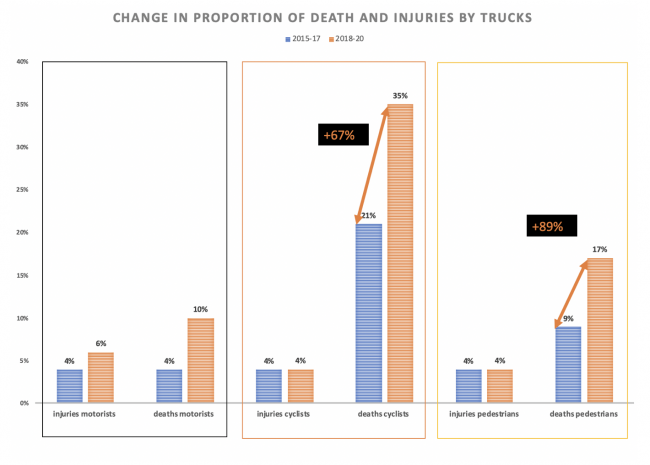While we were in confinement and there was little traffic, two cyclists were killed by SUV drivers in Staten Island. When it comes to risks to cyclists, the focus has long been on trucks, because of their length and driver’s lack of visibility. But the numbers tell a different story: in the last two years, SUVs were involved in 40% of cyclists’ fatalities, exceeding the 35% due to trucks.
Crashmapper.org has a new “vehicle” tab that shows the distribution of crashes by vehicle type for each category of streets users. It allows to compare time periods as well as filter the results by a wide range of geographies.
Comparing 2018-20 to 2015-17, the proportion of crashes by SUVs has shot up considerably across the board. Motorists injured in these crashes nearly doubled since the US emerged from the last recession, while crashes by cars declined proportionally.

The number of motorists injured by trucks also more than doubled in the same period . Most notably, all deaths and injuries do not increase proportionally.

Trucks are now the cause of 35% of cyclists’ deaths while the proportion of pedestrian deaths caused by trucks grew an alarming 89%. Safety for these vulnerable users is another strong argument in favor of moving all deliveries to the night time. Such move would help congestion and we know only too well about blocked bike lanes and obstructed sidewalks. Even during the pandemic, deliveries have continued unabated; the miles traveled by trucks has only dipped by 15% on the highways. The loss of many retailers to the COVID crisis will continue to fuel this trend.
Mandatory night deliveries would relieve some pressure from the many conflicting demands on the parking lane: wider sidewalks, new bike lanes, dining or food vendors? It could also be a great incentive for retailers to adopt cargo bikes as a mode of delivery during the day. Nimbler, safer and greener than the current methods and a sure way to make cycling accepted as a mainstream activity. With proper economic incentives, the City could accelerate this transformation in our post COVID City and save 50 lives each year.
Cyclists are now dying from crashes with SUVs more often than with trucks. The proportion of pedestrians’ deaths by SUVs has grown at an unhealthy clip of 62% , but it remains in line with the increase of the number of SUVs. On the other hand, the 300% jump in proportion of cyclists’ deaths by SUVs is off the charts.

Obviously ,the combination of more cyclists and more SUVs on the road generates a disproportionate growth in crashes. Beyond this explanation, we could venture a number of hypotheses.
It is possible that cyclists are hyper-aware of the dangers of trucks and extra cautious around them, while SUVs do not trigger the same fear? With their constantly increasing size, the recent batch of SUVs poses the obvious problem of width and visibility, just like a truck would. Is it possible that SUV drivers feel more entitled and protected and thus ignore their surroundings?
All these suppositions should be studied by DOT in a formal setting. Still one measure needs to be adopted as soon as possible in the upcoming congestion pricing scheme. Considering the irreparable damage these vehicles and their drivers cause to cyclists and pedestrians – not to mention their negative impact on the environment- tolls should be imposed on SUVs consistent with truck tolls rather than car tolls. For that matter, any vehicle involved in a crash causing death or injuries, should pay much higher tolls for the 5 years following the crash.
